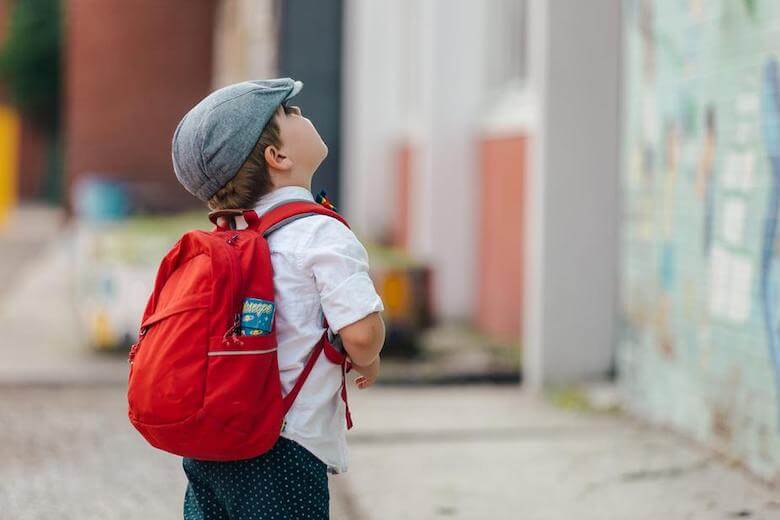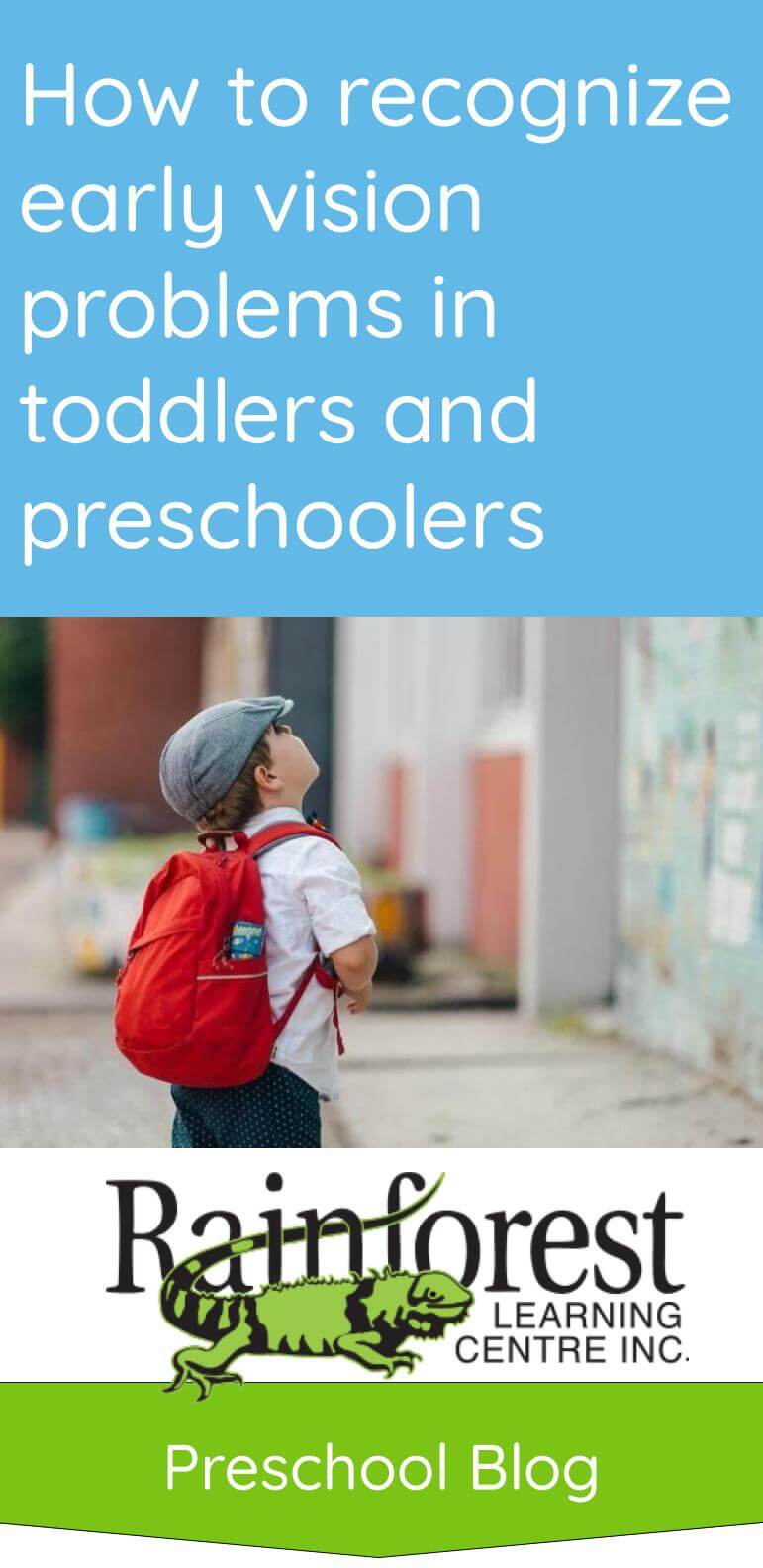
When you speak to parents of kids with vision problems, you may sometimes hear that they had no idea their child wasn’t able to see. It may be that there was no genetic history of vision impairment in the family. So, it may have been hard to suspect. Or, a parent may not have known that babies should get their eyes checked – yes, even babies! In this article, we’ll explain how to recognize early vision problems in toddlers and preschoolers.
The good news is that some vision problems, when caught early, can be treated.
Please note that we are not doctors. Our aim here is to give you some generic advice on common symptoms that are spoken of when describing early childhood vision impairment. That way, if you notice a connection to some of your child’s behaviours, you can seek medical, professional advice.
Common behaviours and signs of vision impairment in children
All babies should be checked for eye alignment and eyesight starting at 6 months of age. Routine checkups are also important.
However, you should get your child checked by an eye doctor if you notice the following:
- Squinting all the time to see things that 20/20 vision would not require.
- Excessive rubbing of the eyes.
- Red eyes.
- Teary eyes, but not from crying.
- Trying to look at things from one eye all the time, or tilting the head to see things.
- Eyeballs that veer inward, outward or otherwise. Sometimes this is called cross-eyed.
- A lazy eye.
- Blinking more than usual.
- Sitting close to the TV, or holding objects very close to their eyes.
- Finding light to be too bright, and closing the eyes or turning away.
- White pupils.
- Inability to follow a moving object with the eyes.
When they get a bit older, you will also want to watch out for things like:
- Holding their hand over one eye to see better.
- Verbal cues, such as, “but I can’t see!” or “where is it?” when something should be visible, and they’re not playing games with you.
- Finding it hard to pay attention to schoolwork, or activities that involve concentration with the eyes.
- Complaining of pain in the eyes or a headache.
Some of the above symptoms can be hard to spot. You’ll notice it can be easy to mistake these signs for something else. For example, an eye infection, or just ‘kids being kids.’ If they tilt their head to look at things, you might even think, “oh they get that from grandma,” assuming it’s just a gesture, or a ‘copycat’ thing they do.
This is why routine checkups by a professional are best. A doctor should be able to spot when something is abnormal. They also can do tests to track eye alignment and vision, in ways you may not know about, or ever thought to try.
Don’t forget the emotional side of vision problems in children
One thing that can often go unmentioned in medical articles about eyesight problems, is the way this affects young children, emotionally.
If you think about it, it can be very frustrating to not have good eyesight. If a child is expected to do things, or act in a certain way, with the assumption their eyes are fine, it can be overwhelming when they feel like they just can’t.
In the baby and toddler years, a child may also be non-verbal. At this time, their only way of communicating their frustration is by showing it, with easy-to-spur crying. While many toddlers do this, and not because of poor vision, it would help to make note if the crying spells are often connected with seeing something.
Children can also exhibit signs that seem ‘normal’ or part of their personality. To give one example, a mom of a girl who needed glasses once explained that her daughter used to be very clingy. She would always want to hold on to her mom. She would also fumble and stumble. But no one in the family had vision problems, so needing glasses was not considered to be the issue. The mom just thought, “why is my daughter so clingy all the time?”
The above example shows that sometimes, the signs can be emotional, too.
If your child is scared of the world, walks indirectly towards the swings, refuses to play at the park, won’t sit for story time or circle time, falls and trips easily – these can also be signs of bad eye vision.
Examples of optical abnormalities that can be diagnosed in childhood
It may help to know what types of eye disorders there are out there. This way, you may better recognize the symptoms noted above, and understand why they are important to watch for.
Childhood-diagnosable eye problems can include:
- Nearsightedness (myopia) or farsightedness (hyperopia), with nearsightedness being more common. This is when it is hard to see things that are far away, or close up.
- Astigmatism (an incorrect eyeball curve causing blurry vision).
- Misalignment errors (strabismus), when one or two eyes is constantly turned inward, outward, upward or downward. This can also cause double vision (diplopia).
Lazy eye (amblyopia), can be caused by any of the above issues. It is serious, and can eventually cause permanent loss of sight in the eye, if not treated early in life. But, thankfully, it can be treated.
Apart from the above, there are also eye diseases that are commonly genetic, or caused at birth, usually in premature babies. These include:
- Retinoblastoma, which is a vision-impairing tumour, and can be recognized by a white pupil.
- Infantile cataracts, which clouds the eyes, affecting vision. This may require surgery.
- Congenital glaucoma, which is pressure build-up in the eye. This may require surgery and medication.
In all of the above cases, glasses and other eye-training therapies may be needed.
A child can also have an infection, such as from herpes or other bacteria or allergic reactions. This is where the red eyes and rubbing of eyes is important to take note of. It is called allergic conjunctivitis. Most of the time it just needs to be treated medically, to heal. In more serious cases, it can cause vision loss. See a doctor if you think your child has this.
To conclude: eyesight problems in young children require regular check-ups, to be sure
Children with eyesight problems may not show obvious symptoms right away. Or, their symptoms can be mistaken for other issues. A parent should be on the lookout for symptoms, of course. That way, vision problems can be treated as soon as possible. However, in addition, the best way to ensure your child’s eye health is optimal, is to see your doctor for routine eye check ups. This should start around 6 months, or as early as your doctor recommends. When vision problems are caught early, they can often be treated, before becoming too serious.
See more on our blog:
- Does my child have a sensory processing disorder or are they just hypersensitive?
- Does my child need a speech therapist? Here is what to know
- Does your child need an occupational therapist? Here is what to know
- What are cognitive developmental milestones in early childhood?
- How to recognize signs of Autism in early childhood and what to do next
